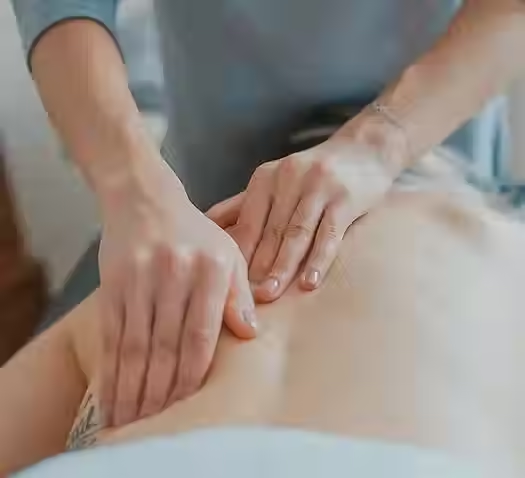
Remedial Massage Therapy
Remedial massage is a complementary therapy that aims to treat muscles that are damaged, knotted, tense or immobile.
It is the scientific manipulation of the soft tissues of the body (i.e. muscles, tendons, ligaments and fascia) for therapeutic or relaxation purposes. Remedial massage is intended as a more targeted treatment for pain and injury.
Depending on the injury or desired outcome, the pressure can be of deep intensity, or it can be more soft and shallow.
The Role of a Qualified Remedial Massage Therapist
Your remedial massage therapist will go through an assessment and examination by identifying, locating and palpating the areas that are relevant to your pain and tightness. Once your remedial massage therapist has determined which tissues are the problem area, they will use the appropriate massage techniques as treatment.
While deep tissue massage is a whole-body treatment, remedial massage focuses on parts of the body that requires rehabilitation. Using a variety of techniques, massage therapists knead, rub or tap areas of the body to improve circulation, relieve pain and tenderness, reduce stress, increase flexibility and relax the whole body by targeting the skeletal, circulatory, muscular, fascial, lymphatic, and nervous systems.



Health Benefits of Remedial Massage
Remedial Massage can increase blood flow within your body to stimulate efficient blood supply to help to heal and repair the specific injury area that has been damaged due to sport activities, daily life activities, working and many more.
Improved blood circulation
Relieves muscle spasms, tightness, soreness and aching
Reduces scar tissue
Calms the nervous system
Reduces stress
Improving joint range of motion
Frequently Asked Questions
-
Head, Neck and Back✔ Acute & chronic low back pain ✔ Chronic back pain ✔ Disc bulges, protrusions, prolapses ✔ Disc degenerative joint disease ✔ Herniated disc ✔ Mid back pain & stiffness ✔ Neck pain, dizziness, vertigo & headaches ✔ Rib cage dysfunction ✔ Scheuermann's disease ✔ Sciatica, nerve pain & nerve radiculopathy ✔ Scoliosis ✔ Spinal stenosis & spinal fusion rehab ✔ Spondylolysis & spondylolisthesis ✔ Thoracic outlet syndrome ✔ T4 syndrome ✔ TMJ dysfunction ✔ Wry neck ✔ Whiplash & concussion
-
Shoulder✔ AC joint sprains ✔ Arthritis ✔ Bankart lesions ✔ Bicep tendon ruptures ✔ Frozen shoulder (Adhesive capsulitis) ✔ Hill Sach lesions ✔ Labral tears ✔ Long thoracic nerve palsy ✔ Pec strains/rupture ✔ Rotator cuff tear and rotator cuff injuries ✔ Scapular dyskinesia ✔ Shoulder impingement ✔ Shoulder instability, dislocation, subluxation ✔ SLAP lesion/tear ✔ Subacromial & subdeltoid bursitis ✔ The painful and stiff shoulder ✔ The painful and unstable shoulder ✔ The painful and weak shoulder
-
Elbow, Forearm and Wrist✔ Bicep tendinopathy ✔ Bicep tendon rupture ✔ Carpal instability ✔ Carpal tunnel syndrome ✔ Colles fracture ✔ Cubital tunnel syndrome ✔ Golfer's elbow (medial epicondylitis) ✔ Guyon's canal syndrome ✔ Olecranon bursitis ✔ Pronator teres syndrome ✔ Radial head fracture ✔ Scaphoid fracture ✔ Smith's fracture ✔ Tennis elbow (lateral epicondylitis) ✔ TFCC injury ✔ Tricep tendinopathy ✔ Ulnar nerve entrapment ✔ Wrist pain with sports
-
Hand, Thumb and Fingers✔ De Quervain's syndrome ✔ Dupuytren's contracture ✔ Finger dislocation ✔ Flexor & extensor tendon injuries ✔ Hand arthritis ✔ Jersey finger ✔ Ligament sprain ✔ Mallet finger ✔ Metacarpal fracture ✔ Nerve pain ✔ Rheumatoid arthritis ✔ Skier's thumb ✔ Swan-neck deformity ✔ Thumb subluxation ✔ Trigger finger
-
Hip and Thigh✔ Adductor strain & tendinopathy ✔ Clinical biomechanics of hip pain & ITBFS ✔ Femoral fracture ✔ Groin pain ✔ Hamstring strain/tear/rupture ✔ Hip dislocation rehab ✔ Hip impingement (FAI) ✔ Iliopsoas tendinopathy ✔ Iliotibial band syndrome ✔ Labral tear ✔ Piriformis syndrome ✔ Quad contusion ✔ Quad strain/tear/rupture ✔ Snapping hip syndrome ✔ Trochanteric bursitis & lateral hip pain
-
Knee✔ Ankle fracture ✔ Achilles rupture ✔ Achilles tendinitis ✔ Achilles tendinopathy ✔ Ankle sprain ✔ Calf pain ✔ Compartment syndrome ✔ Gastroc strain ✔ Peroneal tendinopathy ✔ Peroneal tendon subluxation ✔ Peroneal tendonitis ✔ Posterior tibial tendon dysfunction ✔ Sever's disease ✔ Shin splints ✔ Sinus tarsi syndrome ✔ Tarsal tunnel syndrome ✔ Tibialis anterior dysfunction
-
Ankle and Shin✔ Ankle fracture ✔ Achilles rupture ✔ Achilles tendinitis ✔ Achilles tendinopathy ✔ Ankle sprain ✔ Calf pain ✔ Compartment syndrome ✔ Gastroc strain ✔ Peroneal tendinopathy ✔ Peroneal tendon subluxation ✔ Peroneal tendonitis ✔ Posterior tibial tendon dysfunction ✔ Sever's disease ✔ Shin splints ✔ Sinus tarsi syndrome ✔ Tarsal tunnel syndrome ✔ Tibialis anterior dysfunction
-
Foot✔ Arthritis ✔ Bunions ✔ Flat feet problems ✔ Foot fracture ✔ High arch problems ✔ Heel pain ✔ Hallux valgus ✔ Hallux rigidus ✔ Jones fracture ✔ Lisfranc injuries ✔ Metatarsalgia ✔ Metatarsal fracture ✔ Morton's neuroma ✔ Peripheral neuropathy ✔ Plantar fasciitis ✔ Retrocalcaneal bursitis ✔ Stress fracture ✔ Turf toe
-
Other Conditions✔ Arthritic conditions ✔ Bone spurs ✔ Chronic regional pain syndrome (CRPS) ✔ Compulsory Third Party Insurance (CTP) ✔ Core strengthening ✔ Fractures & casting ✔ Motor Vehicle Accidents Injuries (MVA) ✔ Nerve compression & nerve injuries ✔ Nerve radiculopathy & radicular nerve pain ✔ Osteochondritis dissecans ✔ Pelvic floor rehab ✔ Poor posture - analysis & correction ✔ Post-surgery rehab ✔ Repetitive strain injuries (RSI) ✔ Second opinion physio
Find answers to common questions about remedial massage therapy, its benefits, techniques, and how it helps recovery
